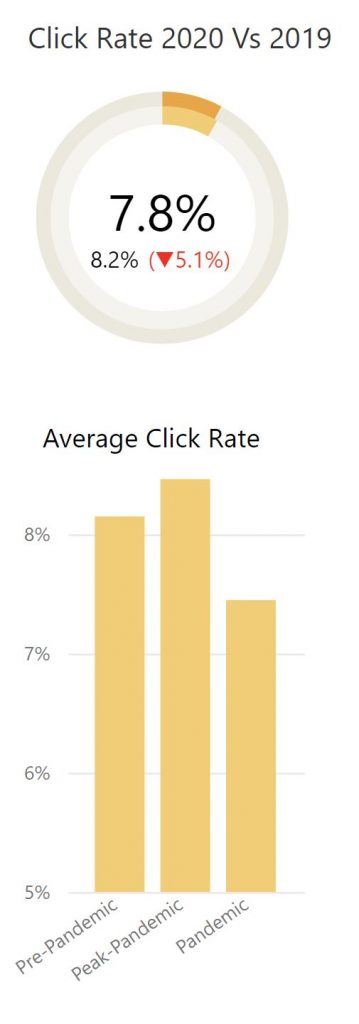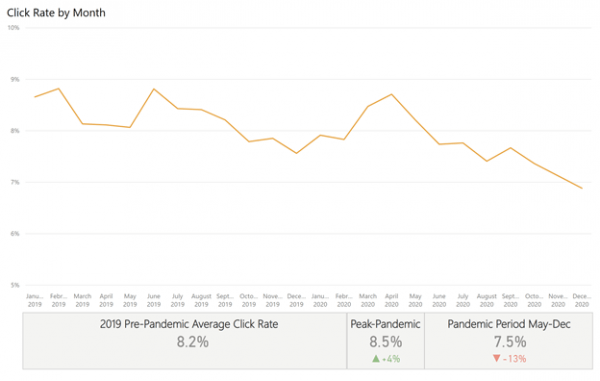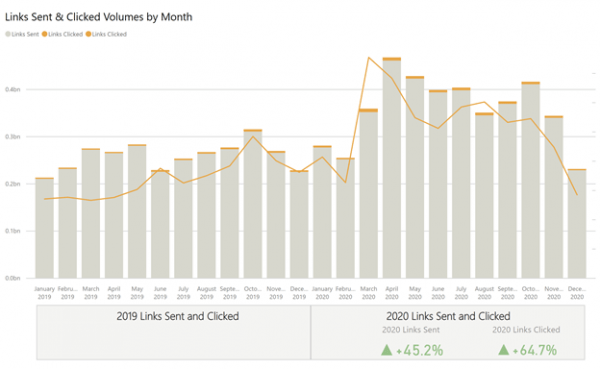Are employees suffering from click fatigue?
Let’s use data to discover why we are seeing a 5% decline in corporate communications click rates this year, but engagement is significantly higher.
Feeling clicked-out? You are not alone.
Suddenly, work is a whole lot more digital and a lot less social. Our schedules are now overloaded with virtual meetings, and our chat channels and inboxes are overflowing. This increased flow of digital communication is taxing our time and attention.
Many of us have experienced “Zoom fatigue,” as near-constant video meetings and real-time chat channels have pushed our cognitive processing to the limit.
Add to that the 100% increase in corporate email volume, and it’s little wonder corporate communicators have noticed a marked decline in their email click-through rates this year. Do we also have click fatigue?
It turns out, according to brainfacts.org, video and chat platforms overtax our brain’s attention systems without providing the social rewards of face-to-face interactions. Video provides constant visual stimuli without the most important body language of all: real eye contact (meaning human contact, not AI-generated digital eye contact algorithms). This solely digital connection leaves us mentally exhausted and dissatisfied.

How much email can employees process?
It also turns out we can only process so much email. The big benefit of email is the DVR effect; we can send and receive on-demand, on our own schedule. Unlike chat, email is a more efficient and reliable work processor, as messages, tasks, reminders and references move from inbox to outbox. But there is a limit. In the past, communicators have heard employee complaints of “too much email,” and now, we are sending nearly double the volume.
Employees are processing twice as many emails during the pandemic than before. With volumes way up, click rates have declined, so let’s look at the evidence for “click fatigue.”
Are declining click-through rates evidence of “click-fatigue”?

This line chart clearly shows a gradual decline in click-through rates of corporate email broadcasts, from nearly 9% down to 7% over a two-year period, and a year-over-year average decline of 5%. (Note: Data is from the 2020 PoliteMail Benchmark Survey, which includes more than 1.2 billion internal corporate emails to more than 8.5 million employees.)
A rudimentary analysis of this click rate suggests the effectiveness of corporate email communications has declined, particularly when the intent of the email message is to get a click to more content. We can see a 4% spike in interest during the peak of the pandemic, but a significant decline thereafter. What’s going on? Is it time to give up on email? Certainly, with this evidence, it appears employees are less engaged with corporate email, right?
Not so fast. Let’s add volume into the picture.
While the volume of links sent has significantly increased, click-through rates have declined 5% year over year.

*Note: December data is only through the 18th
Suddenly, the picture becomes clearer. In this chart, we clearly see the amount of links sent, as a function of email volume, spiked in March and April (the peak of the pandemic) and has remained 50% higher than last year. Employees are receiving significantly more email and many more links to click on.
Consider that the click-through rate is calculated as the percentage of your audience, per email message broadcast, who clicked at least one link. But could they be clicking more? What happens when we change the chart line from click-through rate to the number of links clicked?
The total volume of link clicks is up 65%!

*Note: December data is only through the 18th
Now with the line charting click volume instead of click rate, a marked increase becomes apparent. Not only are we sending close to 50% more links, but people are clicking 65% more links than last year.
This makes it clear that while our click-through rate, on a per-message basis, has declined, our employee engagement with our content, as measured by total number of clicks, is significantly higher on a per capita basis.
Employees are receiving, reading and clicking more email than ever
What can we conclude from all this data? Employees are receiving, reading and clicking on more email than ever. Email engagement, and likely communications engagement in general, is about relevancy.
Engagement occurs when your message matters to the audience. During the peak of the pandemic, we experienced twice the normal volume of corporate email and links being processed, and it remains high.
It’s the higher volume of messages that has affected the per-message click-through rate, even while employees are clicking 65% more links.
So, when corporate communicators receive feedback such as, “You are sending too much email,” they should understand the complaint is not really about the volume or the channel, it’s about the pertinence of the content.
Michael DesRochers is the CEO of PoliteMail, an email intelligence platform for Outlook. This article is in partnership with PoliteMail.






